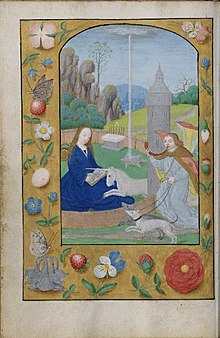Plants in Christian iconography

In Christian iconography plants appear mainly as attributes on the pictures of Christ or the Virgin Mary. Christological plants are among others the vine, the columbine, the carnation and the flowering cross, which grows out of an acanthus plant surrounded by tendrils. Mariological symbols include the rose, lily, olive, cedar, cypress and palm. Plants also appear as attributes of saints, especially virgins and martyrs.
Background[edit]
In Christian art, plants and flowers show up chiefly as traits on the photos of Christ or the Virgin Mary. Plants additionally show up as characteristics of holy people, particularly virgins and saints.[1]
Plants in Christian iconography[edit]
| Flower | Symbol | Reason |
|---|---|---|
| Acacia | The immortality of the soul | Durability of the wood[1] |
| Almond | Divine approval | From the Book of Numbers: "The next day Moses entered the Tent of the Testimony and saw that Aaron's staff, which represented the house of Levi, had not only sprouted but had budded, blossomed and produced almonds."[1][2] |
| Anemone | Crucifixion scenes; also associated with the sorrow of Virgin Mary | Anemones are said to have grown at Golgotha[3] |
| Columbine | Victory of life over death, thus a plant assigned to Christ, furthermore a symbol of humility, the Holy Spirit and the Holy Trinity | The name "columbine" comes from the Latin for "dove", due to the resemblance of the inverted flower to five doves clustered together.[4][3] |
| Daisy | Innocence, beauty, salvation, modesty, purity and love | Simplicity[3] |
| Clover | Holy Trinity, Patrick of Ireland | Three petals that compose a flower[3] |
| Hyacinth | Prudence, constancy, desire of heaven and peace of mind | From the story of Hyacinthus, upon whose death the flower sprung forth[5] |
| Iris | Our Lady of Sorrows | Sharp leaves like swords[3] |
| Lily | Purity, theological virtues of justice, charity and hope; also the Holy Trinity. The White Lily is specific to virginal saints, whether female or male | Lilies with three petals[3] |
| Lily of the valley | Chastity, humility and humbleness of Mary | |
| Palm branch | Martyrdom | Symbol of victory, triumph and peace |
| Passionflower | Crucifixion of Jesus | Each part of the flower represents a different aspect of the Passion of Christ[3] |
| Primula | Virgin Mary | Keys of heaven |
| Rose | Mary, other virgins | The white rose symbolises innocence and faithfulness, the red rose stands for love and passion[3][6] |
| Snowdrop | Virgin Mary | Symbolises hope, purity and virtue |
| Strawberry | Virgin Mary | Symbolises righteousness and humility. Their flowers embody chastity, but they also became a symbol of transience and vanity. The fruit is a symbol for the Incarnation of Christ. |
| White tulip | Holy Spirit | White tulips are used to send a message of forgiveness |
See also[edit]
References[edit]
- ^ a b c Gast, Walter E. (2000). "Symbols in Christian Art and Architecture".
- ^ Numbers 17:1–8
- ^ a b c d e f g h Kostka, Arun Oswin. "Flowers in Christian Symbolism".
- ^ Shorter Oxford English dictionary, 6th ed. United Kingdom: Oxford University Press. 2007. p. 3804. ISBN 978-0199206872.
- ^ "Signs and Symbols". catholictradition.org. Retrieved January 22, 2019.
- ^ Cucciniello, Lisa (2008). "Rose to Rosary: The Flower of Venus in Catholicism". Rose Lore: Essays in Semiotics and Cultural History. Lexington Books. pp. 64–65.
